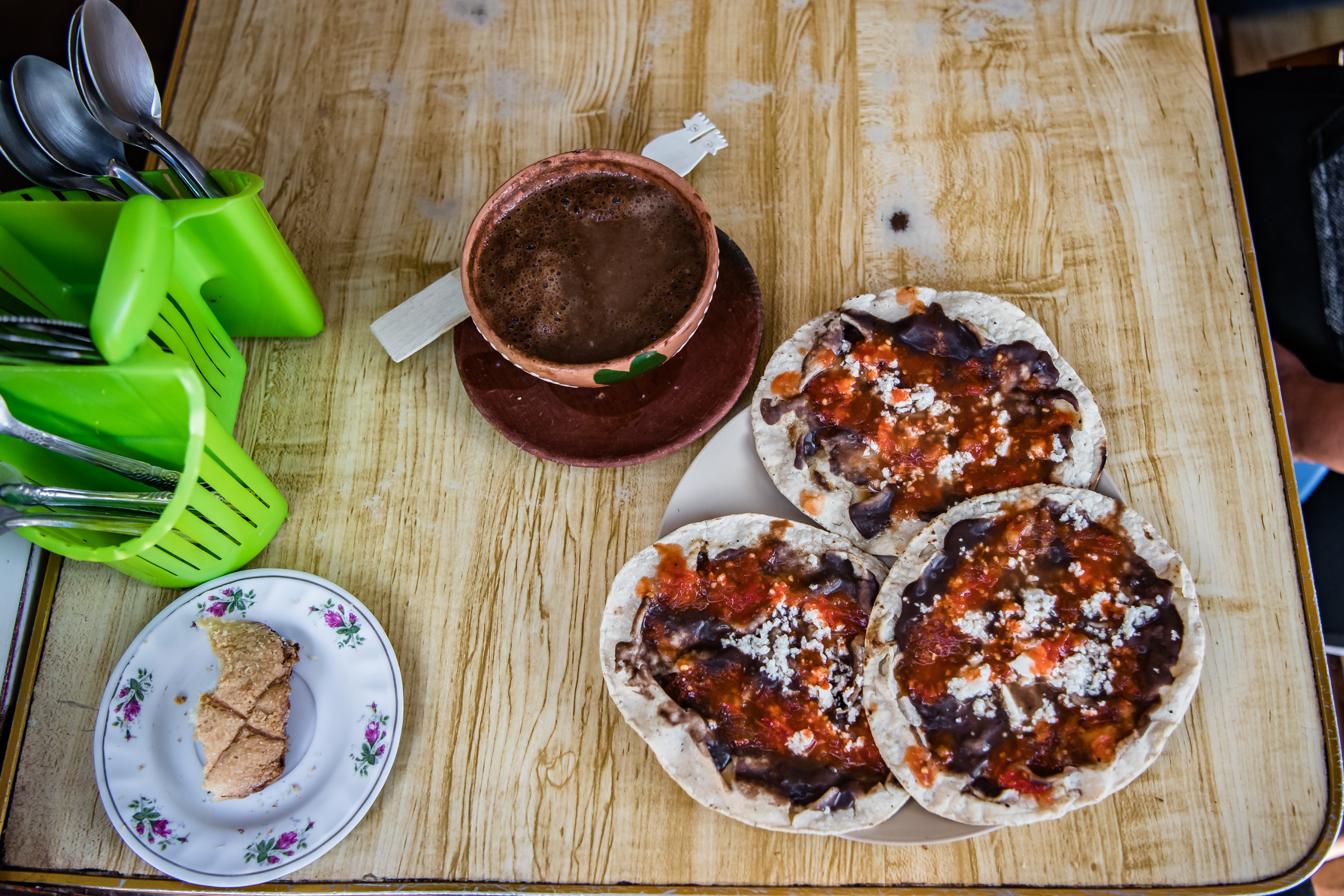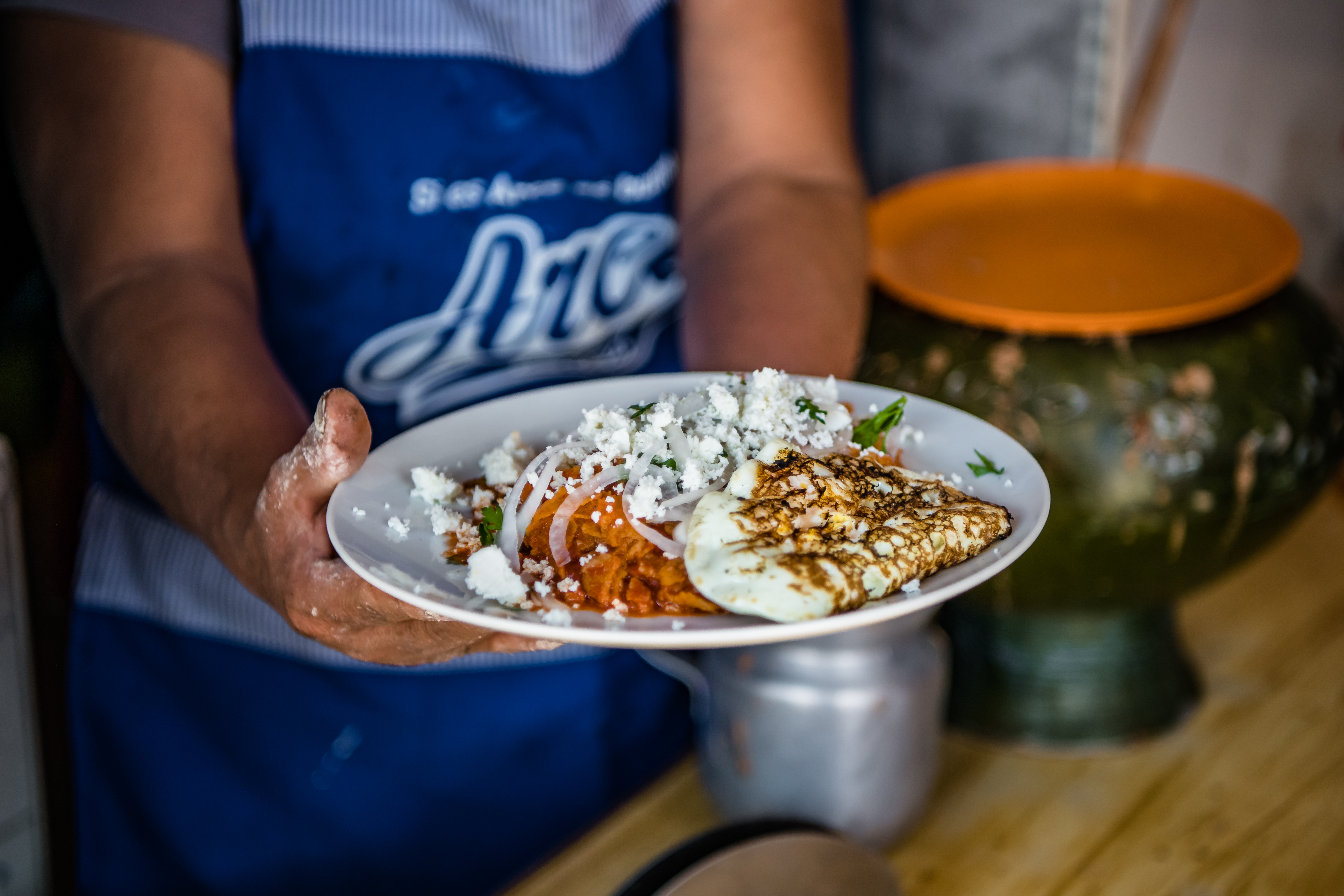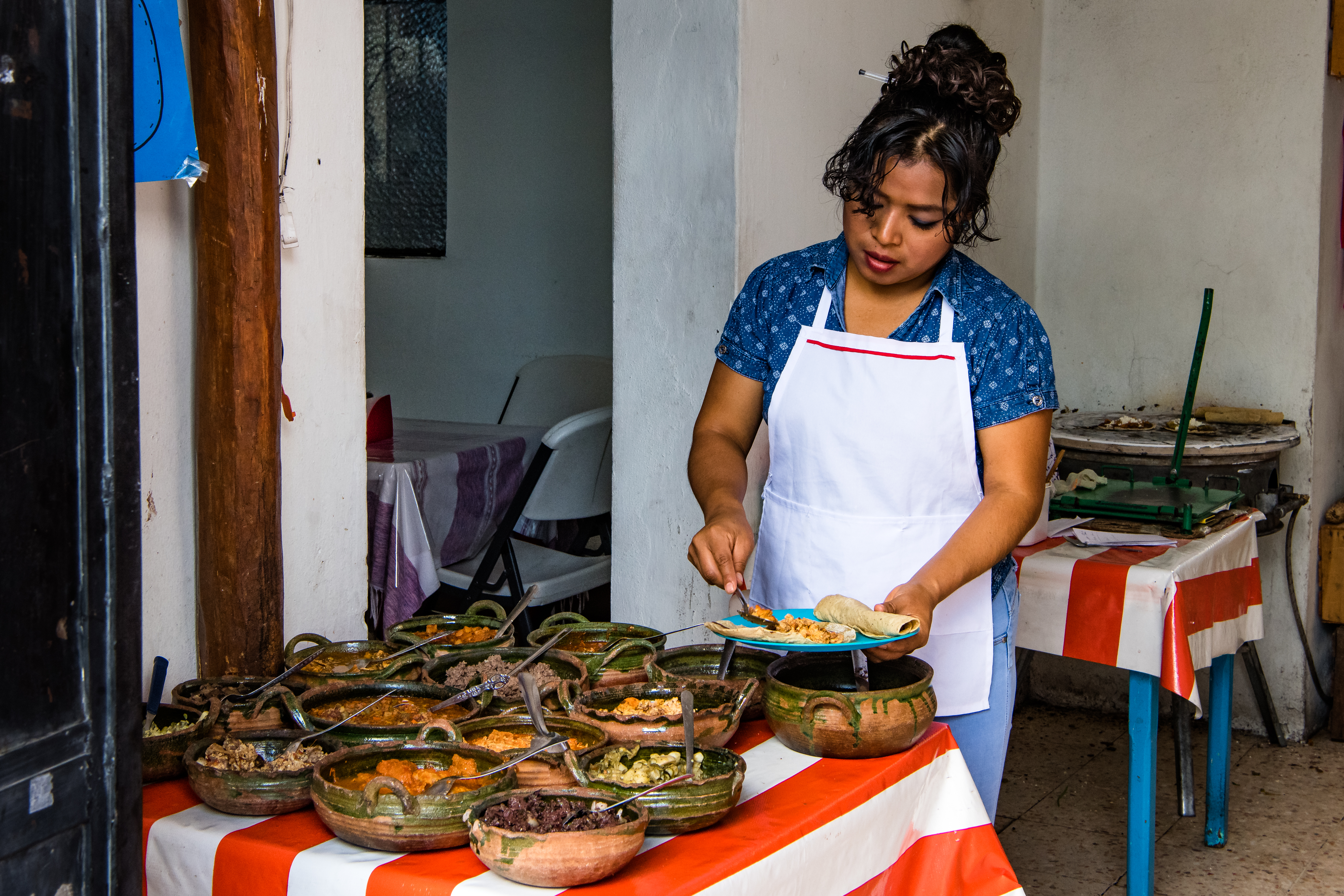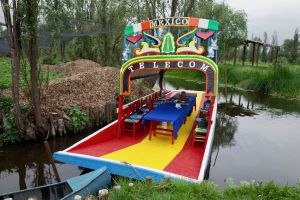On this food tour in Oaxaca, we’ll get an edible crash course on the ingredients and techniques that are a bedrock of traditional Oaxacan cooking and meet some of the people in the kitchen protecting those traditions.
Earth, Corn & Fire: Tasting the Roots of Oaxacan Cuisine
- Culinary walking tour
- Market visit - Eating grilled meats in the smoke corridor
- Tracing corn from raw material
- Sampling a variety of mole
- Untouristed local stops
On this food tour in Oaxaca, we’ll get an edible crash course on the elements that are a bedrock of traditional Oaxacan cooking. We’ll go through neighborhood markets and visit home-based restaurants and the stalls of streets vendors, stopping to taste some of Oaxaca’s most iconic dishes and street snacks, from memelas to eggs cooked on the comal. We’ll taste local corn in various forms and see how it’s transformed from kernel to tortilla, while learning about the key role it still plays in Oaxacan cuisine and culture. Along the way we’ll meet market vendors who have been holding steady for decades and even visit the gallery of a group of young artists who are doing their part to document local life. We’ll end our journey with a meal in a family-run market restaurant, sampling several different types of the city’s most famous creations, mole – a dish that, much like Oaxaca’s rich culinary heritage itself, is the result of numerous ingredients being carefully mixed together.
We like to think of Oaxaca as the heartland of Mexican cooking. All those things that seems so classically and elementally Mexican – corn, chiles, moles, mezcal – can be traced back to the fertile area that surrounds this historic city. This is true about not just ingredients but cooking techniques as well. The use of smoke and fire to flavor food and of the comal – the large circular griddle that is essential for making tortillas – are all deeply connected with the Oaxaca region and its indigenous people. Oaxaca plays another important role: that of a place where many of Mexico’s traditional ingredients and techniques are maintained and protected. Here, the seemingly simple act of growing a strain of heirloom corn is also a deeply political one, an earthy act of resistance against the forces of corporate agriculture that have pushed Mexican farmers in other parts of the country to change the way they work the land.
- All food consumed on the walk – almost a dozen different edible specialties
- Culinary Backstreets Guide
- Alcohol sampled
- Transportation to and from the meeting point
- Food Tasting - Let us know if you have any allergies
- Wear comfortable shoes
- Wear shirts in layers — it can be cooler in the morning and warmer in the afternoon
- Bring an umbrella if you’re traveling in Oaxaca’s rainy season
Cancellation Cutoff: 72 hours
Cancellation Notes: 100% refund if given 1 week notice prior to walk. 50% refund if given 72 hours notice or more. Less than 72 hours before the beginning of the activity or no-show: no refund
| Food Tour - Oaxaca Culinary Backstreets | RETAIL PRICE |
|---|---|
| Adult (13 - years) | $115.00 |
| Child (6 - 12 years) | $57.50 |
- Mercado Benito Juárez, Benito Juarez, Juárez, Puerto Escondido, Oaxaca, Mexico
- Mercado de La Merced, Avenida José María Morelos, RUTA INDEPENDENCIA, Centro, Oaxaca, Mexico
- Taller Lapiztola, Avenida Fuerza Aerea Mexicana, Reforma, Oaxaca, Mexico
- Mercado Sánchez Pascuas, Calle de Tinoco y Palacios, RUTA INDEPENDENCIA, Centro, Oaxaca, Mexico
- Parque Ecoturístico Huayápam, San Andrés Huayapam, Oaxaca, Mexico
- Zona Arqueológica de Atzompa, Cerro de La Campaña, Santa María Atzompa, Oaxaca, Mexico
- Templo de Santo Domingo de Guzmán, Calle Macedonio Alcalá, RUTA INDEPENDENCIA, Centro, Oaxaca, Mexico
- Museum of Cultures of Oaxaca, Santo Domingo, 1a. Cerrada de Macedonio Alcala, RUTA INDEPENDENCIA, Centro, Oaxaca, Mexico
- Mercado 20 de Noviembre, Centro, Oaxaca, Mexico
- Monte Albán Archaeological Site, Ignacio Bernal, San Pedro Ixtlahuaca, Oaxaca, Mexico
- Zócalo Oaxaca, Portal del Palacio, OAX_RE_BENITO JUAREZ, Centro, Oaxaca, Mexico
Liability Waiver
By completing the reservation you acknowledge the following:
If you have food allergies, you are ultimately responsible to ensure your own health and safety. If you share information about your allergies, we can provide you with some guidance about the food purveyors on your tour, but we are not responsible for any allergic reactions that you may have. We are not responsible for any damages or losses incurred as result of acts by entities beyond our control, including but not limited to restaurants, shops, market stalls, eateries and food carts. We are not responsible for acts beyond our control, including but not limited to acts of God, act of nature, acts of war, or other unrest caused by state or non-state actors. If you are disruptive, we have the right to ask you to leave the tour without refunding you or providing you with a credit for your tour. You are aware of and responsible for all damages or losses that may arise during the course of the tour resulting from:
Risks associated with food, water or other drinks, including alcoholic beverages; physical accidents during the tour or at any of the locations visited; transportation failures; forces of nature; criminal activity; damage, loss or misplaced property; or accident or illness without means of rapid evacuation or availability of medical supplies or services. You agree that any claims that may arise will first go to arbitration and only if not resolved in that manner shall be heard in court. In both cases, grievances shall be heard in the jurisdiction of Washington, DC. You further agree to be responsible for your own welfare and property and accept any and all risks of delay, unanticipated events, inconvenience, illness, injury, emotional trauma or death. You further acknowledge that participation in Culinary Backstreets tours is based upon execution of this Liability Waiver. By completing the reservation process you release and discharge forever Culinary Backstreets, its employees, owners, affiliates, officers, directors, successors, agents, and assigns, from and against any liability arising from participating in this tour. You further agree that this release shall be legally binding upon you personally, all members of your family, all minors traveling with you, your heirs, successors, assigns, and legal representatives, to the maximum extent of the law.
I am aware that while on or traveling to or from my activity with Culinary Backstreets, I might be exposed to COVID-19 from other people, animals or objects. I assume all risk of any such contacts, including sickness, incapacity or death and agree to hold harmless Culinary Backstreets from any such developments. In addition, I recognize that the World Health Organization, U.S. Department of State as well as the Centers for Disease Control and Prevention may have warnings concerning same and am choosing to travel and assume all risk myself.
By publishing the stories of our local heroes, visiting them on culinary tours, or directly fundraising for them when they are in need, we attempt to honor their work and their essential role in maintaining the fabric of the city. Our purpose is twofold. Yes, we want to get travelers to some good places to eat. But we also want to make sure that some of these spots and the artisans making food there find a new audience and get the recognition and support they deserve. They are holding back the tide of globalized sameness, which is not easy work – even if it’s done unknowingly. But we believe that every meal counts and, with the help of our audience, they will add up. We are committed to their perseverance and hope that our modest efforts encourage them to keep at it. Our work is also guided by a belief in: Honest Tourism: The places where we eat and craftsmen that we feature on our culinary tours are all selected with this purpose in mind. We’d never accept a free lunch or consider a discount for our tour groups, because that would contradict our central goal, to support them. Nor do our guides receive any commissions from shopkeepers. Honest Journalism: The same principal is applied to the publishing of stories. There are no sponsored posts or even advertising on CB. The writers and photographers are paid fairly for their work on stories that we all believe in.
The cities we are drawn to all have a culinary tradition of untold richness as well as a certain tension, be it political instability, the tug between East and West, the clash between modern and ancient identities, migration, rapid gentrification, bankruptcy, or a post-colonial hangover. Our decision to get started in a city is always the result of a trip filled with many meals where we are given in intimate view of that tension, right there on the table. By getting lost in this warren of independent food purveyors struggling to preserve or adapt tradition in fast-paced urban life, we start to discover the deep complexity and true flavor of the city. At present, you’ll find our regular dispatches from Athens, Barcelona, Istanbul, Lisbon, Los Angeles, Marseille, Mexico City, Naples, Porto, Queens (NY), Shanghai, Tbilisi and Tokyo.
CB’s work was started in 2009 by Ansel Mullins and Yigal Schleifer as a humble food blog called Istanbul Eats. The following year we published a book of our reviews, now in its fifth edition. That year we also launched our first culinary walk in Istanbul, a route we are still using today. In 2012, we realized that what we built in Istanbul was needed in other cities we knew and loved. We started CB that year with Athens, Barcelona, Mexico City and Shanghai as pioneering members of our network. In 2013, we added Rio and also launched our iPhone application in Istanbul. In 2015, Tokyo and Tbilisi came into the fold. That year we published mini-guides to Barcelona and Athens and also launched an iPhone application in those cities. Our Eatinerary service, which provides travelers with tailor-made culinary travel itineraries, was also launched in 2015. In 2016, Lisbon – the latest city to kindle our curiosity – joined the CB network. In 2017 we added Naples and Queens, NY – two places with very compelling stories to tell – to our roster and also published full-size eating guides to Athens and Barcelona. In 2018, Porto joined the list of cities we cover.
- Duration: 5 hours
- Trip difficulty: Easy
- Max Group Size: 7
- Category: Food & Drink


















